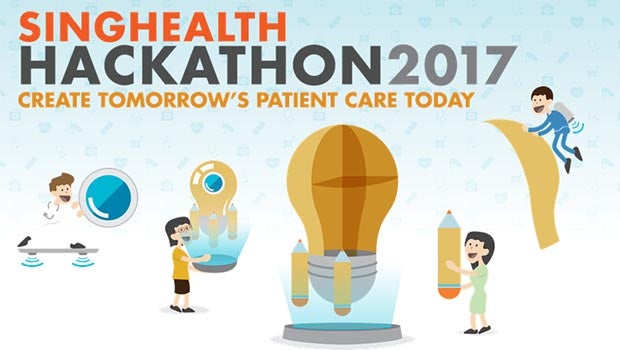
Move over, Whatsapp! New apps and bots now have the potential to improve patient care and efficiency, as can been seen in these five winning innovations at the first SingHealth Hackathon.
Technology for healthcare has never been more exciting, as can be seen in the novel creations offered by 15 teams at SingHealth Hackathon 2017. Over two days, participants discussed issues in healthcare, presented innovative solutions and developed prototypes. Here are five standout innovations that truly epitomise the adage of putting the patient first.
1. More efficient CHIT chat

When doctors discuss cases, they usually communicate using apps like WhatsApp. However, other members of the healthcare team may not be communicating on the same platform. To compound the problem, doctors may be discussing multiple cases on the same chat group, which can cause confusion.
The team at CHIT decided that a single one-stop messaging app was the answer—where one patient would be assigned one chatroom, and all healthcare professionals involved would communicate their care plan for that patient in that chatroom.
"It's about refocusing conversations about the patient," explains Tan Chin Yee, Duke-NUS Medical School student. In CHIT, a patient list is automatically populated from the Electronic Hospital Records, and each patient's chatroom can be accessed by the healthcare team.
Within each chatroom, customisable chat tabs allow for different healthcare providers, such as medical social workers, therapists, nurses and so on, to communicate with each other in a sub-chat containing the relevant providers, depending on the patient's care plan. In time, the team hopes that the app will also be able to import lab and imaging results, medication and past medical records, all in the name of providing better and more timely care for patients
2. Your personal pharmacist

Medications remain a mystery to many patients. Often, patients get instructions mixed up upon reaching home. Even if they remember the dosage they are supposed to take, they are usually unaware what the medication is for, the side effects and so on. Some patients believe that they can stop taking their medication when they feel better, which can have disastrous consequences.
A team, (cleverly calling themselves The Drug Lords), envisioned an app that serves as a personal medication manager. It would remind patients when to take their medication, provide critical information like indications and side-effects, written in plain language and presented in a simple interface.
Ideally, it could be available in different languages, to cater to a larger population. "It's hard for patients to remember so many things in a short time," says Ihtimam Hossain, Pharmacist at SGH. "We hope this app can help them take their medications more regularly. If they adhere to their treatment, their conditions can be better controlled."
3. I like to Move It, Move It

What do you get when you combine the appeal of electronic games with physiotherapy? For the team at Move It!, it was the opportunity to get patients to…well, literally move it. How it works is that a device is attached to a patient's knee. As the patient bends the knee or lifts the leg, it moves an on-screen character. The goal is to help the character climb and clear obstacles.
"Many patients lack the motivation to exercise and this negatively affects their recovery," notes Derek Lee, Physiotherapist at SGH. "The physiotherapists are also unable to attend to all the patients in a day. We needed a solution to address the lack of movement, while minimising the risk of falls and with limited resources."
The team therefore felt that the idea of combining exercise with a game was both interactive and engaging for patients. "Imagine the wards filled with laughter as the game becomes a talking point!" The team is currently targeting patients with lower limb conditions but the concept can also be potentially extended to patients with upper limb problems.
4. At your service, 24/7

Imagine a personal assistant you can message 24/7, who is trained to answer questions and perform certain tasks on your behalf. That is the vision of the Konybot creators, who designed a chat bot to handle some of the common questions asked daily in work chat groups.
Healthcare workers are constantly interrupted at work or having to check their phones regularly to address questions from colleagues. Konybot answers administrative questions, such as room assignments for specific doctors for that day and contact information. It redirects urgent announcements to users and can even provide educational information, allowing healthcare professionals to focus on more critical issues.
Konybot also improves accuracy of information, such as rosters, as it can be updated automatically and in real time. As Konybot is not an app but launched via Facebook or Facebook Messenger, it costs very little to develop and is simple to use, without the need for a separate download.
The hope is that Konybot can be launched as a hospital-wide bot onto a single platform for use by multiple user groups. "This will help to streamline communication and allow ground staff to provide more timely updates and care for patients," shares Audrey Kon, Nurse Clinician at SNEC.
5. A FiDness tracker for better recovery

"Stroke patients spend most of their time in the hospital bed when they should be engaged in activities that can contribute to their recovery," laments Shamala Thilarajah, Senior Physiotherapist at SGH. To get patients moving, TeamFiD has come up with the idea of helping patients monitor their own activity, tapping on existing Radio Frequency Identification (RFID) tags that are currently placed on all patients.
A waterproof inertial measurement unit is attached to the RFID chip. Information on the patient's activity and sleep profile can then be tracked, allowing the therapist to see if the patient has been performing his or her recommended exercises.
Patients will also be able to receive real-time feedback about their progress and hopefully, this will spur them to work on their rehabilitation. The teamhope to have the Bed2FiD system implemented in all rehabilitation units and community hospitals as a common form of activity measurement to improve stroke recovery.
The Winning Teams:

CHIT (L-R): SGH Podiatrists Izza Atiqa Ishak and Tan Qian Ying; Duke-NUS medical students Tan Chin Yee and Zach Tan. Not in picture: Duke-NUS medical student Anthony Li.

The Drug Lords (L-R): SGH hospital executive Kenneth Low, pharmacist Lim Zi Zhao, nurse Suryani Samad, Medical Officer Dr Chinmaya Joshi, Pharmacist Ihtimam Hossain.
The team is pictured with SingHealth Group CEO Prof Ivy Ng (4th from left)

Move It! (L-R): SGH hospital executive Yoecelyn; SGH service operations executive Bryan Chua; Duke-NUS medical student Lim Sze-Xian; SGH physiotherapists Eleanor Chew and Derek Lee.

Konybot (L-R): SingHealth group education executive Clara Lim and SNEC nurse clinician Audrey Kon.

Bed2Fid (L-R): Duke-NUS medical student Shawn Ng, SGH hospital executive Ryan Koh, SGH physiotherapist Shamala Thilarajah, Duke-NUS medical student Tim Chuang and occupational therapist (private practice) Marian Tan.













 Get it on Google Play
Get it on Google Play